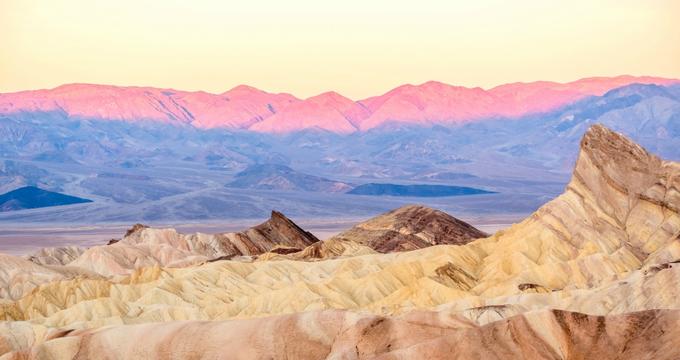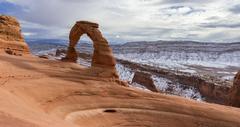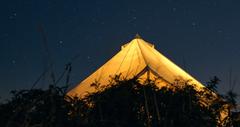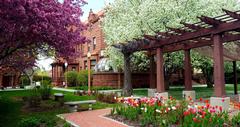Straddling the border between eastern California and Nevada, Death Valley National Park is a land of extremes. Set in a below-sea-level basin, Death Valley experiences extreme heat and steady drought in the summer and snow and rare rainstorms in the winter, creating a vast diversity of fauna and flora in one of the harshest landscapes in the world. Established as a national monument in 1933 and as a national park in 1994, Death Valley National Park is the most significant U.S. National Park outside Alaska, spanning 3.4 million acres with more than 1000 miles of paved and dirt roads. The Park is made up of a variety of landscapes, ranging from low valley floors crusted with barren salt flats, deep and winding canyons, spring-fed oases that teem with wildlife, rolling dunes, and high, rugged, snow-capped mountains. Famous attractions in the Park include Titus Canyon, Badwater Basin’s salt flats, Telescope Peak Trail, the Devil’s Golf Course, and the Mesquite Flat Sand Dunes.
Attractions in the Park
Death Valley National Park’s 3.3 million acres encompass below-sea-level salt flats, mountain-size dunes, colorful sandstone canyons, and mysterious singing rocks. The lowest spot in the park is Badwater Basin, which rests at 282 feet below sea level, while the highest point is Telescope Peak, which soars to 11,049 feet above sea level.
Badwater Basin and Artist’s Drive are, undoubtedly, two of Death Valley’s most photogenic spots. Resting at 282 feet below sea level, Badwater Basin was once a vast expanse of salt flats and salty puddles, however, has now dried up to a surreal area of crunchy salt crystals. Artist’s Drive is a scenic nine-mile road that offers beautiful vistas of the Amargosa Range’s sedimentary hills and their multi-hued palette of pinks, golds, greens, and lavender. Get the best sunset views of the folded and rippled Golden Canyon cliffs from Zabriskie Point, which offers a spectacular panorama of the many-hued badlands from a 100-yard-long paved trail.
The Ubehebe Crater is a half-mile-wide, 600-foot crater formed from molten lava meeting groundwater just over 300 years ago. The volcano has colorfully striped layers of orange and rusty sedimentary soil and can be viewed up close to a hiking trail that runs along the southwest rim towards several other craters, including Little Hebe.
The silky, rippled Mesquite Flat Sand Dunes are 100-foot high dunes that are easily accessible and offer breathtaking views at sunrise or sunset with long shadows and soft light making fantastic photo opportunities. The Dunes are home to rattlesnakes through so be aware.
Mosaic Canyon features polished marble narrows and colorful, slick rock embedded with multi-colored rock fragments known as Mosaic Breccia. One of the most popular scenic highlights of Death Valley, Mosaic Canyon can be explored on a hiking trail that ends at a dry waterfall.
Once part of a massive freshwater lake, Death Valley has Salt Creek, which is the last remaining remnant of this lake and home to the rare pupfish, a living fossil that evolved to survive when the lake’s water changed from freshwater to saltwater.
Things to Do
Death Valley National Park offers a variety of activities and things to do for the whole family, including exploring the Furnace Creek Visitor Center, visiting the Borax Museum, which tells the story of the history of borax in Death Valley and has an exciting mineral collection, and watching a 20-minute introduction film about the park in the Visitor Center. Outdoor activities range from hiking, backpacking, and camping to mountain biking, birding, and sightseeing. Game rangers offer guided tours of the Park, along with nature walks, patio talks, and night programs.
Educational Programs
Death Valley National Park offers a variety of educational and community outreach programs for visitors of all ages, including adult’s classes, activities for children and families, Junior Ranger Programs, Junior-Ranger guided tours of the park, nature walks, patio talks, and night programs.
Nearby Attractions
Nearby attractions include the Amargosa River Natural Area, the Ash Meadows National Wildlife Refuge, the Borax Museum on Furnace Creek Ranch, the China Ranch Date Farm, the Eastern California Museum, the Goldwell Open Air Museum in Rhyolite Ghost Town, and the Manzanar National Historic Site. Other attractions worth visiting include the Tecopa Hot Springs and the Trona Pinnacles.
Visitor Information
Death Valley National Park is located in Death Valley near the border of California and Nevada and is open year-round. The Furnace Creek Visitor Center offers a variety of information about the park, various exhibits, and a 20-minute introduction film about the park, where visitors can learn more about the abundant cultural and natural resources of the park.





